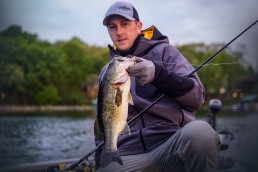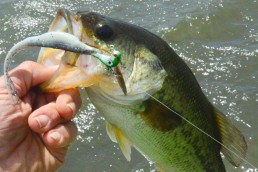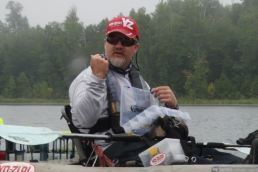Use the Right Hooks When Fishing Soft Plastics
SHARE THIS POST
No matter how many soft plastic baits are out on the market or in your tackle box, they are worthless without a good hook. With a wide variety of specialty hooks available to anglers, it’s no longer as simple as saying, “I need some hooks.” That’s why I wanted to take a deeper dive and break it down to help make sure you use the right hooks when fishing soft plastics for bass.
The hook itself has developed and evolved over the years, and now these super-sharp and strong hooks can help increase your hook-up ratio, along with allowing your plastic baits to move more naturally in the water. Hooks come in a wide range of styles, sizes and colors, and each one of these hooks has a specific plastic bait and fishing application in which it will shine.
When discussing hooks for bass fishing applications, there are three core groups that a hook can fall into:
Worm hook
This style of hook is what paved the way for plastic worm fishing and is still used by anglers when rigging up a worm on a Texas or Carolina rig. A worm hook usually has a longer shaft, which puts the hook point further down on your soft plastic bait, making a great choice for worms, lizards or soft plastic stickbaits.
Having a variety of sizes in this style hook is important, as you’ll want to use the right size hook that puts the hook point somewhere on the plastic bait that increases your hook-ups, while not impeding the action of the bait. I typically keep a selection of 3/0 to 6/0 TroKar Pro V Bend Worm Hooks in my boat. I like the Pro V style from TroKar, as I feel they have a little more room for the plastic to slide on the hook set, resulting in increased hook-ups.
Extra wide gap
This has become a staple in all bass fisherman’s tackle boxes and works well when using a wide variety of soft plastic baits such as craws, creatures and flukes. The key characteristic of the extra wide gap is that when you rig a bulky plastic lure on the hook, there will still be room on the hook for the plastic to shift when you set the hook on a bass. This ensures that you get the best possible hook-up on that hookset.
I’ll use this hook on a creature bait in lieu of the below-mentioned flipping hook when I’m making longer pitches or casts to a target, such as a weedline or point. I like how a soft plastic bait looks on an extra wide gap when making a cast, compared to a flipping style hook.
These hooks both come in standard and a 2X or Magworm model; the latter is designed for fishing with braided or heavier fluorocarbon line. I’ll keep a selection of both standard extra wide gap and Magworm models from TroKar in 1/0 all the way up to 6/0. When I’m making longer casts or fishing a bait on a Carolina Rig, I’ll typically use the standard, while the Magworm gets the nod when fishing in heavy vegetation.
Are you enjoying this post?
You can be among the first to get the latest info on where to go, what to use and how to use it!
Specialty hooks
Hook manufacturers have developed their lines of hooks based off input from anglers on creating specific hooks for given techniques used to catch bass. Regardless if you are a tournament bass angler, die hard angler or just a weekend fisherman, I urge you to check out these specialty hooks, because they will allow your plastic baits to perform better in the water and will greatly increase your hooking percentage. Here is a brief rundown of some popular technique-specific hooks:
Tube baits: A specific hook for a tube bait is a must, as this bait has two walls of plastic to get through when setting the hook. The Lazer TroKar Tube Hook utilizes the TroKar Barb; this barb keeps the tube in place as you are fishing it. The design of this hook also puts the barb of the hook right in the sweet spot, along with allowing it to be rigged smoothly.
Flipping: Without a doubt, one of the most sought-after specialty hooks on the market is a flipping hook. These stout hooks are straight-shank hooks, which increases the hook-up percentage when flipping. Securing the bait on the hook is very important, because the proper presentation is crucial when dropping a bait in front of bass’s face. Many manufacturers have a flipping style hook. TroKar has three flipping hook styles: standard, Pro V Flip and Monster Flipping.
Swimbait: The soft plastic swimbait has grown to be a mainstay lure in many bass anglers’ arsenals. The two key characteristics of a swimbait hook is some sort of a plastic keeper, an angled hook eye and possibly a weight on the bend of the hook. These hooks are especially designed to allow your swimbait to swim naturally in the water, as if they aren’t swimming naturally, it is likely a bass won’t show interest in it.
Drop Shot: Finesse fishing for bass is becoming more crucial for success, primarily because bass are seeing more and more pressure on our lakes and rivers. Since these hooks are predominately small (I use a 1 or 1/0) an extremely sharp hook is even more important now than ever.
Finesse: This newer-style of hook to the bass fishing market in the last few years is used by anglers for wacky rigging stickbaits, drop shotting or Neko-rigging. The Pro V Bend Finesse Hook from TroKar has a unique Pro V bend design, which keeps your soft plastics in place, resulting in less time rigging baits and more time with your bait being properly presented in the water. A weedless version that features hand-tied weedguards is available as well for skipping under boat docks and fishing shallow water cover.
As you look to stock up your tackle box for that next bass fishing trip, be sure to have a wide variety of hooks for your plastics. The styles above will cover any soft plastic bait that you may have, and by carrying hooks in a wide array of sizes, you’ll be able to select the right hook to match the sizes and applications of your plastic baits.
Become a MidWest Outdoors Insider here!
MWO
SHARE THIS POST
Did you enjoy this post?
You can be among the first to get the latest info on where to go, what to use and how to use it!
Glenn Walker
Glenn Walker has been fishing Minnesota and Mississippi River tournaments for more than 15 years, spreading his passion and knowledge of the sport via articles and videos. For more information, check out glennwalkerfishing.com or on Facebook @GlennWalkerFishing.



